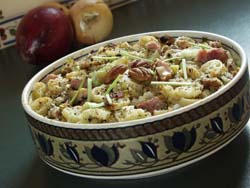 |
The recipe (serves
4)
|
|
Garnish (Optional)
|
|
In a thick-bottomed saucepan, melt 1 soupspoon of
butter. Fry the two garlic cloves and the
onion in it until they
become soft, but not brown. Incorporate the mushrooms and the spices
until the mushrooms release their water, which takes a few minutes.
(As a variation of this recipe
add the mushrooms at the end of the
process if you want them to be a little crisper.) Add flour
and cook
for 1 minute stirring without allowing it to turn brown. Using a whisk,
gradually
incorporate the milk, the broth and the wine until all the
lumps are gone. Continue the cooking
stirring until the sauce thickens and
comes to a boil. Do not let it boil.
Meanwhile cook the pasta “al dente”. Drain and add
it to the sauce along with the chicken,
parsley
and Parmesan. Pour into a casserole.
Garnish: in a small frying pan melt the butter at
low heat. Brown the garlic. Add the
breadcrumbs,
parsley and Parmesan. Mix well. Spread over the casserole.
Cook in the oven at 180°C (375°F) for 30 minutes
until the sauce starts bubbling
and the
breadcrumbs become golden brown. |
The Diva
Luisa Tetrazzini was born in Florence in 1871. Legend has it that she started singing at the age of three and that her sister Eva, also a soprano, taught her everything she knew. Luisa had her debut at the age of 19 in the role of Inez in Meyerbeer’s Africana, at the Theatro Pagliano in Florence. A number of stories are going around regarding this famous premiere. They say that Luisa was sitting in the audience that night when it was announced that the prima donna was indisposed. She got up and said: “Don’t despair maestro, I know the part by heart. I’ll sing it!” More realistically, Charles Neilson Gattey, author of the biography entitled Luisa Tetrazzini: The Florentine Nightingale, wrote that
Luisa who was then married to Giuseppe Scalaberni, the manager of the theatre
building, would slip backstage to attend all the rehearsals, memorising the
part. When the soprano announced she was sick, she was ready to take her place.
But it doesn’t matter how it happened. That night Luisa received a huge ovation
that launched her career.
From 1891 to 1906 she sang in Italy, Eastern Europe, South America, Spain and Mexico. In 1907, following a number of intrigues she managed the tour de force of singing the role of Violetta (La Traviata) at Covent Garden, while the reigning diva
was on tour outside the country. Tetrazzini returned to Covent Garden every year
from 1908-1912.
Numerous legal battles punctuated her career. The management at New York’s Metropolitan made a serious mistake by not reading her contract closely and she quietly went off to Oskar Hammerstein I’s Manhattan Opera, to sing Lakmé, Dinorah and Elvira (I
Puritani). Luisa Tetrazzini finally sang 8 times at the met during the
1911-1912 season in the roles of Lucia, Guilda and Violetta. In 1910 an argument
broke out when banker Otto Khan helped the Met buy back Hammerstein’s contract.
The diva “ran off” to San Francisco not heeding the injunction and feeding the
gossip of the local papers. She told the press that she was prepared to sing in
the street if it came to that. True to her word, Tetrazzini sang before a
delighted crowd estimated at over 200,000 people on Christmas Eve 1910, in front
of the San Francisco Chronicle Building.
Critics at the time often praised her acting talents as
well as her exceptional voice. The diva had quite a reputation for the ease with
which she interpreted the coloratura parts and for the high bright register of
her voice. Until the end of her career she could still easily sing a high E even
if the rest of her register had somewhat deteriorated. She sang until 1934 to
generate revenue, which her numerous ex-husbands were quick to dilapidate. She
died in 1940 in a state of utter poverty. She is reported to have said a short
time before her death, “I am old, I am fat, I am ugly but I remain
Tetrazzini!”
A number of the diva’s recordings are available on CD, such as a 3-CD EMI pack Luisa Tetrazzini: The London
Recordings. The diva also published an autobiography in 1921: Tetrazzini on the Art of Singing.


